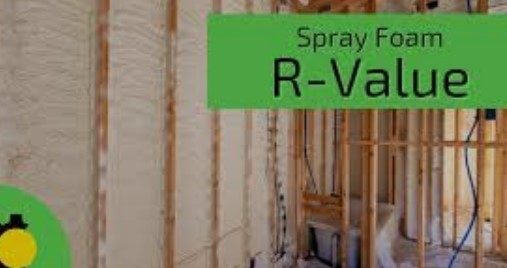Spray foam attic insulation effectively seals and insulates your attic, reducing energy costs and better regulating your home’s temperature. It fills gaps and cracks, providing a seamless barrier against air infiltration, making it an efficient solution for attic insulation.
If you’re looking to improve your home’s energy efficiency and comfort, spray foam attic insulation is a smart choice. By creating an air-tight seal, it prevents air leakage and heat loss, ultimately reducing energy bills. In this guide, we’ll explore the benefits, installation process, and cost considerations of spray foam attic insulation, helping you make an informed decision for your home.
Whether you’re concerned about energy efficiency, air quality, or overall comfort, spray foam insulation offers a comprehensive solution for your attic insulation needs
Understanding The R-value Concept In Insulation
Spray foam attic insulation is a popular choice for homeowners looking to increase the energy efficiency of their homes. One important concept to understand when it comes to insulation is the R-value. The R-value measures the insulation’s resistance to heat flow, with a higher R-value indicating better insulation performance.
It is crucial to select spray foam insulation with the appropriate R-value for your attic, as this will ensure maximum energy savings and comfort in your living space. Additionally, understanding the R-value concept can help you make an informed decision when choosing insulation materials for your home.
When looking for spray foam attic insulation, it is important to consider not only the R-value but also the installation process and the overall effectiveness in preventing air leakage. In conclusion, by understanding the R-value concept and following these guidelines, you can make the right choice for your attic insulation needs.
Properties And Composition Of Spray Foam Insulation
Spray foam insulation is an effective and efficient way to insulate your attic. It is composed of two chemical components, polyol resin, and isocyanate, which are combined to create a foam-like substance. When sprayed onto the desired area, the foam expands and fills all the nooks and crannies, creating an airtight seal.
This results in improved thermal performance and energy efficiency for your home. Spray foam insulation also has excellent soundproofing properties, reducing noise transmission between different areas of your house. Additionally, it acts as a barrier against moisture, preventing the growth of mold and mildew.
Unlike traditional insulation materials such as fiberglass or cellulose, spray foam insulation does not sag or settle over time, ensuring long-lasting effectiveness. Overall, the unique properties and composition of spray foam insulation make it a superior choice for attic insulation.
Factors Influencing The R-value Of Spray Foam Insulation
Spray foam insulation is an effective option for attic insulation due to its high R-value, which measures a material’s thermal resistance. Several key factors influence the R-value of spray foam insulation. Firstly, the type of spray foam used is crucial.
Open-cell spray foam, with its lower density, offers a lower R-value compared to the closed-cell variety. Secondly, the thickness of the foam layer also affects the R-value. Increasing the thickness will result in higher thermal resistance. Additionally, proper installation is vital to maximize the R-value.
Gaps or improper sealing can lead to air leakage, reducing the insulation’s effectiveness. Lastly, climatic conditions play a significant role. Cold climates require higher R-values for optimal insulation, whereas warmer climates may require lower values. Considering and understanding these factors will ensure that you achieve the desired insulation performance in your attic with spray foam insulation.
Importance Of Proper Installation Techniques For Maintaining R-value
Spray foam attic insulation is an essential component for maintaining the R-value of a home. Proper installation techniques are crucial for ensuring maximum efficiency and long-term performance. It is important to adhere to specific guidelines to avoid any loss of insulation effectiveness.
Ensuring thorough coverage and sealing off air leaks is essential to prevent energy waste and maintain a comfortable indoor environment. By investing in professional installation and following industry best practices, homeowners can enjoy the benefits of optimal energy efficiency and cost savings.
Proper installation techniques not only maximize the R-value of spray foam attic insulation but also contribute to the overall comfort and sustainability of a home.
Comparing R-values: Spray Foam Insulation Versus Traditional Insulation Materials
Spray foam attic insulation provides a higher R-value compared to traditional insulation materials, making it an efficient choice for maintaining a comfortable indoor temperature and reducing energy costs. The R-value of spray foam insulation is significantly higher than that of materials such as fiberglass and cellulose.
This means that it offers better thermal resistance, which is essential for effectively controlling heat flow. The air-sealing properties of spray foam insulation also contribute to its superior performance in comparison to traditional materials. Proper insulation is crucial for preventing energy loss and maintaining a consistent indoor climate, and spray foam insulation is a compelling option for achieving these objectives.
Conclusion
Spray foam attic insulation offers numerous benefits for homeowners. With its ability to create an airtight seal and resist moisture, it provides superior insulation that can lead to energy savings and a more comfortable living environment. Additionally, spray foam insulation helps to reduce the risk of mold and extends the lifespan of your roof.
Consider investing in this cost-effective and eco-friendly solution to optimize your home’s energy efficiency and overall comfort.
